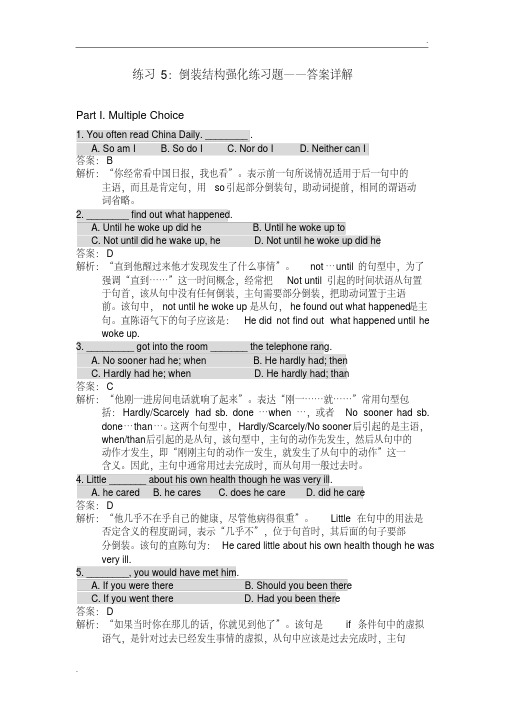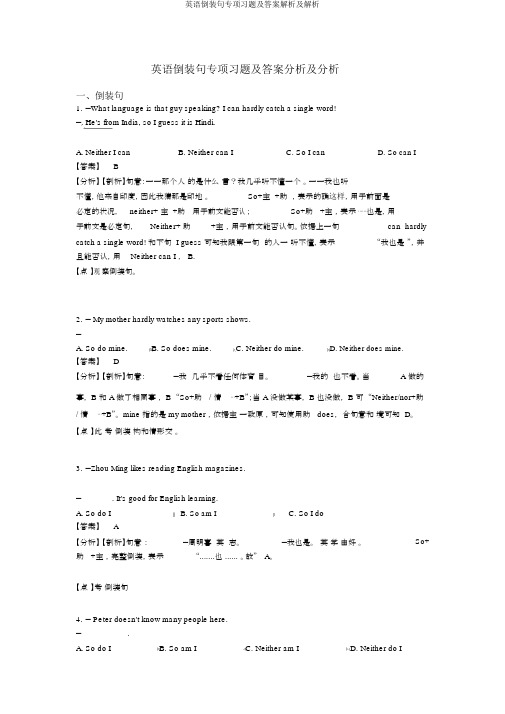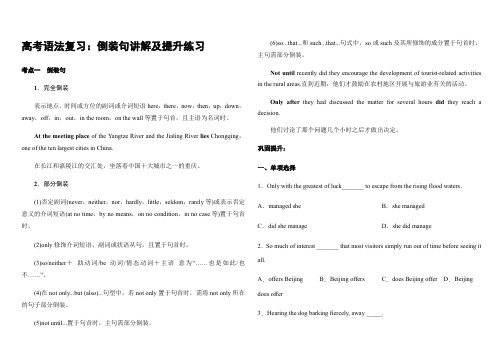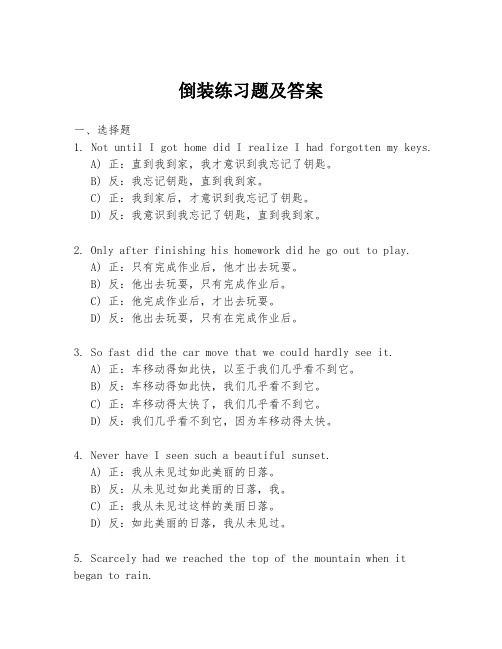大学英语词汇与语法练习5:倒装结构强化练习题(答案及详解)
【英语】英语倒装句练习题含答案及解析

【英语】英语倒装句练习题含答案及解析一、倒装句1.—My brother and I will go to the library tomorrow.— . Shall we go together?A. So do IB. So I doC. So will ID. So I will 【答案】 C【解析】【分析】“so+助动词(情态动词或连系动词)+另一主语”,此句型是主谓倒装结构,可以表示前面的情况也适用于后者,使用该句型需要注意以几个方面的问题:1.该句型只能用于肯定句,不能用于否定句:如果前句是否定句,则要用“neither /nor +助动词+主语”。
2.句型中的主语与上文中的主语是不同的两个主语3.句型中助动词,包括连系动词和情态动词的时态要和上句中谓语动词的时态相一致。
句意:我的哥哥和我明天要去图书馆。
根据下文,我们一起去吗?可知上文情况同样适用于后者,故用主谓倒装结构,上文是将来时态,选C。
【点评】这几个倒装句的区别比较难。
“so+助动词(情态动词或连系动词)+另一主语”,表示前面的情况也适用于后者。
So+主语+助动词(情态动词或连系动词)是对上文所说的情况加以肯定。
如果上文是否定形式则要将so换成neither。
2.— I can't stand (忍受) the air pollution in this city any more. It is getting more terrible.— ________. We've never had so many factories before.A. Neither I can .B. Neither can IC. So I can.D. So can I.【答案】 B【解析】【分析】句意:-我不能在忍受这个城市里的空气污染了,它变得更糟糕了。
-我也不能,我们以前从来没有这么多工厂。
Neither也不,是否定意思,位于句首,应该用倒装,故A不对;C和D应该用于肯定句中,这里是否定句。
大学英语词汇与语法练习5:倒装结构强化练习题(答案及详解)

4. Little _______ about his own health though he was very ill.
A. he cared B. he cares C. does he care D. did he care
答案: D
解析:“他几乎不在乎自己的健康,尽管他病得很重”。 Little 在句中的用法是
any money be given…”,根据句子含义,句首应该有否定含义的词汇或短
语(在句中充当状语 ),因此才会出现倒装。 所给 4 个选项只有 on no account
(绝不、无论如何不、切莫)是否定含义并且可以在句中充当状语。
注意:by (from) all accounts “据说 ,据报道 ,根据各方面所说”, (be) of no account
14. ___________ that they may eventually reduce the amount of labor needed on
construction sites by 90 percent.
A. So clever are the construction robots
.
.
给选项只有 D 有动词。同时, Not only 置于句首,句子应部分倒装,把助
动词置于主语前面,遇到 be 动词,则直接把 be 动词置于主语前面。该句
的直陈句为: France Viuard was not only an excellent political speaker, but she
A. she could have faced with
B. could have she faced with
C. she could have been faced with
英语英语倒装句专项学习的试题及答案解析及解析

〔英语〕英语倒装句专项习题及答案解析及解析一、倒装句1.— All the students are working hard now.—_______. Because all of them want to go to good colleges.A. So are theyB. Neither they areC. So they areD. So they do【答案】C【解析】【分析】句意:——所有的学生都在努力学。
——确如此。
因他都想要去好的大学。
so+助〔情或系〕+主,⋯⋯也是,前后主不同。
so+主 +助,确如此,前后主一致。
根据下文all of them可知上下文主是一致的,用“so+主 +助〞。
上文助是are,下文也用are,故 C。
【点】考倒装句,注意so+助〔情或系〕+主和so+主 +助的和用法。
2.—I couldn't work out the math problem.—________. I found ________ difficult for us to do it.D. Neither I could; itA. So could I; thisB. Neither could I; itC. So can I; that【答案】B【解析】【分析】句意:——我算不出道数学。
——我也不能。
我解决个于我来很。
第一空考倒装构,我我做它很。
上句生一件事,下句有同事情生,后面的句子用倒装构,前面的句子是否认句,后面的倒装句用Neither引,Neither+ 助 +主。
第二空考it作形式,主++it+形容+for 是形式,不定式是真正的,故B。
【点】此考倒装构和it 用法。
注意neither引的倒装句用法和固定句式构:主++it+形容 +for sb. to do sth.3.— I can't stand 〔忍受〕the air pollution in this city any more. It is getting more terrible.— ________. We've never had so many factories before.A. Neither I can .B. Neither can IC. So I can.D. So can I.【答案】B【解析】【分析】句意:-我不能在忍受个城市里的空气染了,它得更糟糕了。
英语倒装练习题及答案解析--

英语倒装练习题及答案解析1.—David has made great progress recently.—_____, and _____.A. So he has; so you haveB. So he has; so have youC. So has he; so have youD. So has he; so you have【答案】B【解析】译文:—David最近取得了很大进步。
—的确,你也是。
本题考查“也”和“的确如此”的表达。
表达“也”用“so+ be/助/情+主语”,表达“的确如此”用“so+主语+be/助/情”,故选B。
2.There _____.A. come theyB. they comeC. they are comeD. will they come【答案】B【解析】译文:他们来了。
本题考查全部倒装。
There位于句首时,句子要全部倒装,但主语是人称代词时,不倒装,排除A、D;be后面不能加动词原形,排除C。
故选B。
3.Only an hour ago _____ out why he was absent.A. did the teacher foundB. the teacher foundC. did the teacher findD. had the teacher found【答案】C【解析】译文:直到一个小时前,老师才发现他缺席了。
本题考查部分倒装。
Only+状语位于句首时,句子要部分倒装,排除B;根据句意可知,要用一般过去时,排除D;did后面加动词原形,故选C。
4._____ that they made an important discovery in science.A. Little they realizedB. They had realized littleC. Little did they realizeD. Little had they realized【答案】C【解析】译文:他们几乎没有意识到他们在科学上有了重大的发现。
英语倒装句专项习题及答案解析及解析

英语倒装句专项习题及答案分析及分析一、倒装句1.—What language is that guy speaking? I can hardly catch a single word!—. He's from India, so I guess it is Hindi.A. Neither I canB. Neither can IC. So I canD. So can I 【答案】B【分析】【剖析】句意:一一那个人的是什么言?我几乎听不懂一个。
一一我也听不懂,他来自印度,因此我猜那是印地。
So+主 +助,表示的确这样,用于前面是必定的状况,neither+ 主 +助用于前文能否认;So+助 +主,表示⋯⋯也是,用于前文是必定句,Neither+ 助+主,用于前文能否认句。
依据上一句can hardly catch a single word! 和下句 I guess 可知我跟第一句的人一听不懂,表示“我也是”,并且能否认,用Neither can I , B.【点】观察倒装句。
2.— My mother hardly watches any sports shows.—_________A. So do mine.B. So does mine.C. Neither do mine.D. Neither does mine.【答案】D【分析】【剖析】句意:—我几乎不看任何体育目。
—我的也不看。
当 A 做的事, B 和 A 做了相同事, B “So+助 / 情⋯+B”;当 A 没做某事, B 也没做, B 可“Neither/nor+助/ 情⋯+B”。
mine 指的是 my mother ,依据主一致原,可知使用助 does,合句意和境可知 D。
【点】此考倒装构和情形交。
3.—Zhou Ming likes reading English magazines.—_______. It's good for English learning.A. So do IB. So am IC. So I do【答案】A【分析】【剖析】句意:—周明喜英志。
高考语法复习:倒装句讲解及提升练习(有答案)

高考语法复习:倒装句讲解及提升练习考点一倒装句1.完全倒装表示地点、时间或方位的副词或介词短语here,there,now,then,up,down,away,off,in,out,in the room,on the wall等置于句首,且主语为名词时。
At the meeting place of the Yangtze River and the Jialing River lies Chongqing,one of the ten largest cities in China.在长江和嘉陵江的交汇处,坐落着中国十大城市之一的重庆。
2.部分倒装(1)否定副词(never,neither,nor,hardly,little,seldom,rarely等)或表示否定意义的介词短语(at no time,by no means,on no condition,in no case等)置于句首时。
(2)only修饰介词短语、副词或状语从句,且置于句首时。
(3)so/neither+助动词/be动词/情态动词+主语意为“……也是如此/也不……”。
(4)在not only...but (also)...句型中,若not only置于句首时,需将not only所在的句子部分倒装。
(5)not until...置于句首时,主句需部分倒装。
(6)so...that...和such...that...句式中,so或such及其所修饰的成分置于句首时,主句需部分倒装。
Not until recently did they encourage the development of touristrelated activities in the rural areas.直到近期,他们才鼓励在农村地区开展与旅游业有关的活动。
Only after they had discussed the matter for several hours did they reach a decision.他们讨论了那个问题几个小时之后才做出决定。
倒装句讲解及巩固提升练习(有答案)

倒装句讲解及练习形式倒装(1)感叹句:What + a/an + adj +n.+(主语+谓语)!How + adj /adv.+(主语+谓语)!(2)The+比较级+正常语序句子,The+比较级+正常语序句子。
“越……,越…….。
”(3)Whatever+n.+主语+谓语,主句。
However+ adj/adv+主语+谓语,主句。
C、完全倒装(五全)有时表地方1. “有”There be结构。
另外,在此结构中可以用来代替be动词的动词有:exist, seem, happen, appear, live, rise, stand等。
如:There stood a dog before him.There exist different opinions on this question.2. “时”在以now、then等开头的句子里。
“Now, Then + come (或be, go, lie, run) + 主语" 结构。
Then came the hour we had been looking forward to.Now comes your turn.3. “表”有时候为了强调表语,把表语置于句首,倒装结构为“表语+系动词+主语”(1)形容词+系动词+主语Present at the meeting were Professor White and many other guests.(2)过去分词+系动词+主语Gone are the days when they could do what they liked to the Chinese people.(3)介词短语+be+主语Among the goods are Christmas trees, flowers, candles and toys.4. “地”当表示地点的副词和介词词组(如here, there, on the wall, under the tree, in front of the house, in the middle of the room等)在句首时。
倒装练习题及答案

倒装练习题及答案一、选择题1. Not until I got home did I realize I had forgotten my keys.A) 正:直到我到家,我才意识到我忘记了钥匙。
B) 反:我忘记钥匙,直到我到家。
C) 正:我到家后,才意识到我忘记了钥匙。
D) 反:我意识到我忘记了钥匙,直到我到家。
2. Only after finishing his homework did he go out to play.A) 正:只有完成作业后,他才出去玩耍。
B) 反:他出去玩耍,只有完成作业后。
C) 正:他完成作业后,才出去玩耍。
D) 反:他出去玩耍,只有在完成作业后。
3. So fast did the car move that we could hardly see it.A) 正:车移动得如此快,以至于我们几乎看不到它。
B) 反:车移动得如此快,我们几乎看不到它。
C) 正:车移动得太快了,我们几乎看不到它。
D) 反:我们几乎看不到它,因为车移动得太快。
4. Never have I seen such a beautiful sunset.A) 正:我从未见过如此美丽的日落。
B) 反:从未见过如此美丽的日落,我。
C) 正:我从未见过这样的美丽日落。
D) 反:如此美丽的日落,我从未见过。
5. Scarcely had we reached the top of the mountain when it began to rain.A) 正:我们刚刚到达山顶,就开始下雨。
B) 反:我们到达山顶,刚刚开始下雨。
C) 正:我们刚到山顶,就下雨了。
D) 反:开始下雨,我们刚刚到达山顶。
二、填空题6. _______ the letter, I threw it away immediately.A) ReadingB) Having readC) To readD) Read7. _______ the news, she burst into tears.A) HearingB) Having heardC) To hearD) Heard8. _______ the test, he felt relieved.A) PassedB) Having passedC) To passD) Passing9. _______ the room, she turned on the light.A) EnteringB) Having enteredC) To enterD) Entered10. _______ the book, he fell asleep.A) ReadingB) Having readC) To readD) Read三、改错题11. Little did I know that the project was already completed.A) 正:我几乎不知道项目已经完成了。
- 1、下载文档前请自行甄别文档内容的完整性,平台不提供额外的编辑、内容补充、找答案等附加服务。
- 2、"仅部分预览"的文档,不可在线预览部分如存在完整性等问题,可反馈申请退款(可完整预览的文档不适用该条件!)。
- 3、如文档侵犯您的权益,请联系客服反馈,我们会尽快为您处理(人工客服工作时间:9:00-18:30)。
练习5:倒装结构强化练习题——答案详解Part I. Multiple Choice1. You often read China Daily. ________ .A. So am IB. So do IC. Nor do ID. Neither can I Il4Lu。
答案:B解析:“你经常看中国日报,我也看”。
表示前一句所说情况适用于后一句中的主语,而且是肯定句,用so引起部分倒装句,助动词提前,相同的谓语动词省略。
2. ________ find out what happened.A. Until he woke up did heB. Until he woke up to OYH5M。
C. Not until did he wake up, heD. Not until he woke up did he VHHR9。
答案:D解析:“直到他醒过来他才发现发生了什么事情”。
not …until的句型中,为了强调“直到……”这一时间概念,经常把Not until引起的时间状语从句置于句首,该从句中没有任何倒装,主句需要部分倒装,把助动词置于主语前。
该句中,not until he woke up是从句,he found out what happened是主句。
直陈语气下的句子应该是:He did not find out what happened until he woke up.3. _________ got into the room _______ the telephone rang.2LZln。
A. No sooner had he; whenB. He hardly had; then u09Sk。
C. H ardly had he; whenD. He hardly had; than QhBD9。
答案:C解析:“他刚一进房间电话就响了起来”。
表达“刚一……就……”常用句型包括:Hardly/Scarcely had sb. done …when …,或者No sooner had sb.done …than …。
这两个句型中,Hardly/Scarcely/No sooner后引起的是主语,when/than后引起的是从句,该句型中,主句的动作先发生,然后从句中的动作才发生,即“刚刚主句的动作一发生,就发生了从句中的动作”这一含义。
因此,主句中通常用过去完成时,而从句用一般过去时。
4. Little _______ about his own health though he was very ill.xWk7D。
A. he caredB. he caresC. does he careD. did he care CHnGA。
答案:D解析:“他几乎不在乎自己的健康,尽管他病得很重”。
Little在句中的用法是否定含义的程度副词,表示“几乎不”,位于句首时,其后面的句子要部分倒装。
该句的直陈句为:He cared little about his own health though he was very ill.5. ________, you would have met him.A. If you were thereB. Should you been there0YvwT。
C. If you went thereD. Had you been there mFYbH。
答案:D解析:“如果当时你在那儿的话,你就见到他了”。
该句是if条件句中的虚拟语气,是针对过去已经发生事情的虚拟,从句中应该是过去完成时,主句是助动词+have done,完整的句子应该是If you had been there, you would have met him.为强调,省略了if后,把从句中的助动词提前,该句中的助动词为had,直接放到主语前,构成部分倒装。
6. Seldom _________ such a funny story as he told us.AHTD5。
A. have I heardB. I have heardC. did I listenD. I listened xLSgP。
答案:A解析:“我很少听到像他所讲的这样好笑的故事”。
Seldom是否定意义的频率副词,表示“(次数)很少”,置于句首应部分倒装。
该句的直陈句为:I seldom have heard such a funny story as he told us.注意:B选项的错误在于没有倒装。
C和D选项的主要错误在于listen是vi., 只有listen to才能接宾语。
7. So loudly _______ that all the people in the room got a fright. OS8sA。
A. he shoutedB. shout heC. did he shoutD. he did shout lK6n7。
答案:C解析:“他喊得如此大声以致于屋里的所有人一阵惊惧”。
so/such …that句型中,当so/such …位于句首时,其后的主句中应部分倒装(注意,that引起的是从句,that前面的是主句)。
该句的直陈句为:He shouted so loudly that all the people in the room got a fright.8. Rarely _______ so difficult a problem.A. she could have faced withB. could have she faced with 782Qq。
C. she could have been faced withD. could she have been faced with osYBv。
答案:D解析:“她几乎不可能面对过这样的难题”。
Rarely是否定意义的副词,表示“很少、几乎不”,置于句首时,句子要部分倒装,把助动词置于主语之前。
该句的直陈句为:She could rarely have been faced with so difficult a problem.注意:该句中的could not/rarely/hardly have done结构表达的是对过去事情的推测,表示主语“过去不太可能做……”。
表达对过去发生的事情的肯定的推测,一般用must have done的结构,意为主语“过去可能做过……”。
9. Not a single mistake _______ in the test.A. he madeB. did he makeC. he has madeD. made he lNc2h。
答案:B解析:“他在测验中一个错误都没犯”。
该句是把宾语前置,为了强调,把否定词也前置了。
否定副词Not置于句首表达强调时,句子要部分倒装,把助动词置于主语前面。
该句的直陈句为:He did not make a single mistake in the test.10. Hardly _______ the classroom when the class began. gKiRy。
A. had he enteredB. he had enteredC. he enteredD. he was entered UGb7R。
答案:A解析:“他刚一进教室就开始上课了”。
详细解析参考上面第3题。
11. ____ France Viuard an excellent political speaker but she was also among the first members of the Democratic Party. X2FsR。
A. Not onlyB. If onlyC. OnlyD. Not only was c06xZ。
答案:“France Viuard不仅是一位出色的政治演说家,同时也是民主党最早的党员之一”。
该句题干所给句子中,but前面的句子部分,明显缺少动词。
所给选项只有D有动词。
同时,Not only置于句首,句子应部分倒装,把助动词置于主语前面,遇到be动词,则直接把be动词置于主语前面。
该句的直陈句为:France Viuard was not only an excellent political speaker, but she was also among …”12. _________ should any money be given to a small child.xMKTV。
A. On no accountB. From all accounts aTt9X。
C. Of no accountD. By all accounts答案:A解析:“无论如何都不应该给小孩子钱”。
该句题干部分已经有部分倒装“should any money be given …”,根据句子含义,句首应该有否定含义的词汇或短语(在句中充当状语),因此才会出现倒装。
所给4个选项只有on no account (绝不、无论如何不、切莫)是否定含义并且可以在句中充当状语。
注意:by (from) all accounts “据说,据报道,根据各方面所说”,(be) of no account “不重要”。
这些短语了解即可。
主要的考点为on no account。
13. So badly ________ in the accident that Simon was delayed in the hospital fortreatment.w6kxT。
A. did he injureB. he injuredC. was he injuredD. he was injured答案:C解析:“Simon在事故中受伤如此严重以致于他在医院中耽了更多的时间进行治疗”。
该题详解参考上面第7题。
该句直陈句为:He was so badly injured in the accident that Simon was delayed in …注意:表达某人受伤,injure通常都用被动态,be injured。
14. ___________ that they may eventually reduce the amount of labor needed on construction sites by 90 percent.MuGfB。
A. So clever are the construction robotsB. So clever the construction robots areC. Such construction robots are cleverD. Such clever construction robots are答案:A解析:“建筑机器人如此聪明,最终可能能够减少建筑工地90%的劳动力”。
